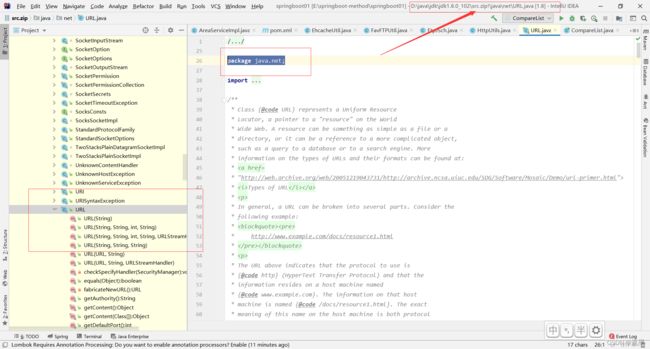Java 发送Http get/post请求,调用Http接口、方法
Java 发送Http get/post请求,调用Http接口、方法
- Java 发送Http get/post请求
-
- URL包实现
-
- POST请求
- GET请求
- httpclient包实现
-
- POST请求
- GET请求
Java 发送Http get/post请求
本篇文章主要通过以下俩种包实现get/post请求方法!
- java.net.URL
- org.apache.http.client
URL包实现
当前实现所需要的URL是在package java.net包下,点击查看源码,由此可知,此包是JDK自带的包!使用URL发送Http请求使用的是最原始方法发送!

POST请求
废话不多说,直接上代码,如下所示:
/**
* 向指定 URL 发送POST方法的请求
*
* @param url
* 发送请求的 URL (可以将参数丢url后面传过去URL?productCode=YUNPHMIP)
* @param param
* 请求参数,请求参数应该是json的形式。
* @return 所代表远程资源的响应结果
*/
public String sendPost(String url, String param) {
PrintWriter out = null;
BufferedReader in = null;
String result = "";
try {
URL realUrl = new URL(url);
// 打开和URL之间的连接
URLConnection conn = realUrl.openConnection();
// 设置通用的请求属性
conn.setRequestProperty("accept", "*/*");
conn.setRequestProperty("connection", "Keep-Alive");
conn.setRequestProperty("user-agent",
"Mozilla/4.0 (compatible; MSIE 6.0; Windows NT 5.1;SV1)");
// 发送POST请求必须设置如下两行
conn.setDoOutput(true);
conn.setDoInput(true);
// 设置编码格式
conn.setRequestProperty("Charset","UTF-8");
conn.setRequestProperty("Content-type", "application/json;charset=UTF-8");
// 获取URLConnection对象对应的输出流
out = new PrintWriter(conn.getOutputStream());
// 发送请求参数
out.print(param);
// flush输出流的缓冲
out.flush();
// 定义BufferedReader输入流来读取URL的响应
in = new BufferedReader(
new InputStreamReader(conn.getInputStream()));
String line;
while ((line = in.readLine()) != null) {
line = new String(line.getBytes(), "utf-8");
result += line;
}
} catch (Exception e) {
e.printStackTrace();
}
//使用finally块来关闭输出流、输入流
finally{
try{
if(out!=null){
out.close();
}
if(in!=null){
in.close();
}
}
catch( IOException ex){
ex.printStackTrace();
}
}
return result;
}
若发送过程中存在乱码,解决办法如下所示:
// 获取URLConnection对象对应的输出流
OutputStream os = conn.getOutputStream();
OutputStreamWriter ow = new OutputStreamWriter(os, "UTF-8");
out = new PrintWriter(ow);
// 发送请求参数
out.print(param);
// flush输出流的缓冲
out.flush();
GET请求
具体代码如下所示:
/**
* 向指定URL发送GET方法的请求
*
* @param url
* 发送请求的URL
* @param param
* 请求参数,请求参数应该是 name=value&name1=value1 的形式。
* @return URL 所代表远程资源的响应结果
*/
public static String sendGet(String url, String param) {
String result = "";
BufferedReader in = null;
try {
String urlNameString = url + "?" + param;
URL realUrl = new URL(urlNameString);
// 打开和URL之间的连接
URLConnection connection = realUrl.openConnection();
// 设置通用的请求属性
connection.setRequestProperty("accept", "*/*");
connection.setRequestProperty("connection", "Keep-Alive");
connection.setRequestProperty("user-agent",
"Mozilla/4.0 (compatible; MSIE 6.0; Windows NT 5.1;SV1)");
// 建立实际的连接
connection.connect();
// 获取所有响应头字段
// Map<String, List<String>> map = connection.getHeaderFields();
// 定义 BufferedReader输入流来读取URL的响应
in = new BufferedReader(new InputStreamReader(
connection.getInputStream()));
String line;
while ((line = in.readLine()) != null) {
result += line;
}
} catch (Exception e) {
e.printStackTrace();
}
// 使用finally块来关闭输入流
finally {
try {
if (in != null) {
in.close();
}
} catch (Exception e) {
e.printStackTrace();
}
}
return result;
}
httpclient包实现
使用此方法实现需要引入pom文件,具体引入文件如下所示:
<!-- https://mvnrepository.com/artifact/org.apache.httpcomponents/httpclient -->
<dependency>
<groupId>org.apache.httpcomponents</groupId>
<artifactId>httpclient</artifactId>
<version>4.5.3</version>
</dependency>
<!-- https://mvnrepository.com/artifact/org.apache.httpcomponents/httpcore -->
<dependency>
<groupId>org.apache.httpcomponents</groupId>
<artifactId>httpcore</artifactId>
<version>4.4.8</version>
</dependency>
POST请求
具体代码如下所示:
private static CloseableHttpClient httpClient = HttpClientBuilder.create().build();
/**
* get请求
* @param url
* @return
*/
public static String get(String url) {
CloseableHttpResponse response = null;
BufferedReader in = null;
String result = "";
try {
HttpGet httpGet = new HttpGet(url);
RequestConfig requestConfig = RequestConfig.custom().setConnectTimeout(3000).setConnectionRequestTimeout(3000).setSocketTimeout(3000).build();
httpGet.setConfig(requestConfig);
httpGet.setConfig(requestConfig);
httpGet.addHeader("Content-type", "application/json; charset=utf-8");
httpGet.setHeader("Accept", "application/json");
response = httpClient.execute(httpGet);
in = new BufferedReader(new InputStreamReader(response.getEntity().getContent()));
StringBuffer sb = new StringBuffer("");
String line = "";
String NL = System.getProperty("line.separator");
while ((line = in.readLine()) != null) {
sb.append(line + NL);
}
in.close();
result = sb.toString();
} catch (IOException e) {
e.printStackTrace();
} finally {
try {
if (null != response) {
response.close();
}
} catch (IOException e) {
e.printStackTrace();
}
}
return result;
}
GET请求
具体代码如下所示:
private static CloseableHttpClient httpClient = HttpClientBuilder.create().build();
/**
* post请求
* @param url
* @param jsonString
* @return
*/
public static String post(String url, String jsonString) {
CloseableHttpResponse response = null;
BufferedReader in = null;
String result = "";
try {
HttpPost httpPost = new HttpPost(url);
RequestConfig requestConfig = RequestConfig.custom().setConnectTimeout(30000).setConnectionRequestTimeout(30000).setSocketTimeout(30000).build();
httpPost.setConfig(requestConfig);
httpPost.setConfig(requestConfig);
httpPost.addHeader("Content-type", "application/json; charset=utf-8");
httpPost.setHeader("Accept", "application/json");
httpPost.setEntity(new StringEntity(jsonString, Charset.forName("UTF-8")));
response = httpClient.execute(httpPost);
in = new BufferedReader(new InputStreamReader(response.getEntity().getContent()));
StringBuffer sb = new StringBuffer("");
String line = "";
String NL = System.getProperty("line.separator");
while ((line = in.readLine()) != null) {
sb.append(line + NL);
}
in.close();
result = sb.toString();
} catch (IOException e) {
e.printStackTrace();
} finally {
try {
if (null != response) {
response.close();
}
} catch (IOException e) {
e.printStackTrace();
}
}
return result;
}
以上就是俩种不同包的连接方法!若有不足之处,请您指正!